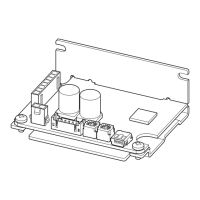18
Connection
6.10 Conformity to the EMC Directive
Eective measures must be taken against the EMI that the motor and driver may give to adjacent control-system
equipment, as well as the EMS of the motor and driver itself, in order to prevent a serious functional impediment in the
machinery. The use of the following installation and wiring methods will enable the motor and driver to be compliant
with the EMC directive. Refer to p.67 for the applicable standards.
Oriental Motor conducts EMC measurements on its motors and drivers in accordance with "Example of installation and
wiring" shown on the next page.
The user is responsible for ensuring the machine’s compliance with the EMC Directive, based on the installation and
wiring explained below.
This equipment is not intended for use in residential environments nor for use on a low-
voltage public network supplied in residential premises, and it may not provide adequate
protection to radio reception interference in such environments.
About power supply
The
BLH
Series is a product of DC power supply input. Use a DC power supply (such as a switching power supply) that
optimally conforms to the EMC Directive.
Connecting the motor cable
When extending the motor cable, use a connection cable (sold separately). The maximum extension distance including
the cable length of the motor itself should be 2 m (6.6 ft.).
Ferrite core
Use a ferrite core to suppress eect by noise propagation.
Use 7427122 (Würth Elektronik GmbH & Co.KG), ZCAT3035-1330 (TDK Corporation) or equivalent ferrite cores.
Install the ferrite core as close as possible to the driver.
Wiring the I/O signal cable
Refer to "Prevention of noise propagation" on p.17.
Notes about installation and wiring
•
Connect the motor, driver and other peripheral control equipment directly to the grounding point so as to prevent a
potential dierence from developing between grounds.
•
When relays or electromagnetic switches are used together with the system, use noise lters and CR circuits to
suppress surges generated by them.
•
Keep a power supply cable and signal cable as short as possible without coiling and bundling extra lengths.
•
Separate power lines such as motor cable and power supply cable from signal lines, and wire them apart as much
as possible [example: about 100 to 200 mm (3.94 to 7.87 in.)]. If the power lines must cross over the signal lines, wire
them at right angles.

